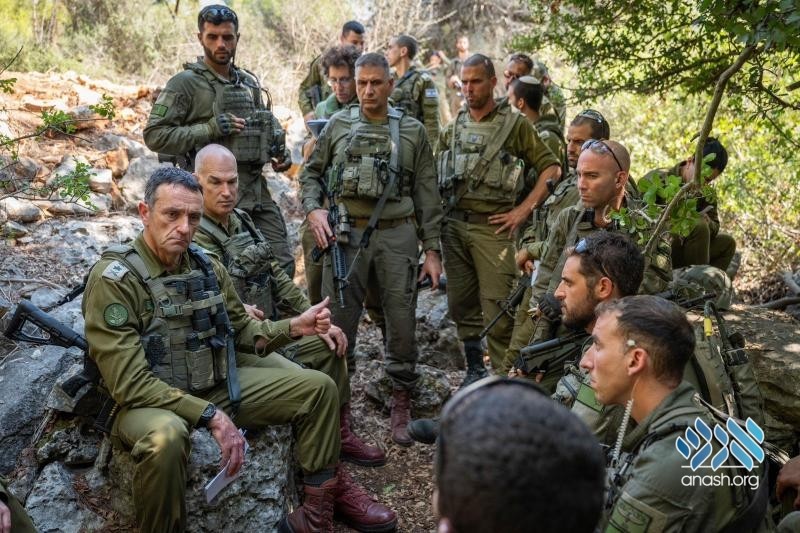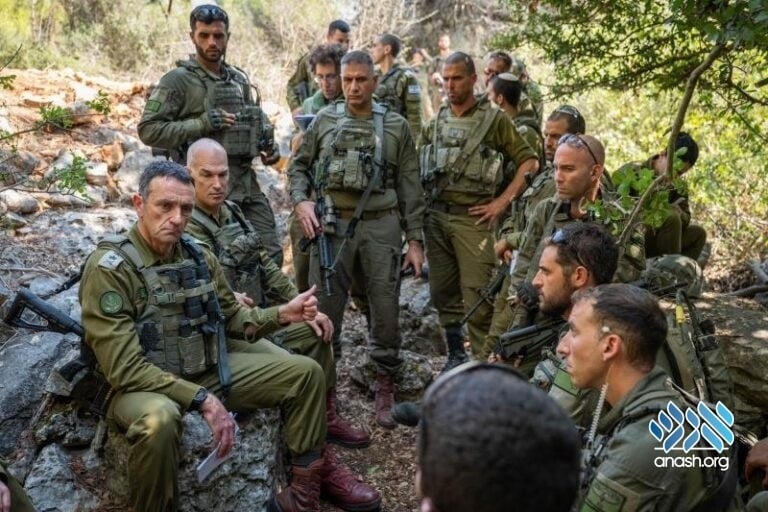כ״ג אלול ה׳תשפ״ד | September 25, 2024
War Day 355: IDF Strikes Near Beirut, Preparing for Ground Entry
War Summary, Day 355: U.S. & France trying to negotiate a 21-day ceasefire in Lebanon, Hezbollah’s first missile at Tel Aviv, IDF began striking Hezbollah intelligence bases near Beirut, Chief of Staff says IDF preparing for ground maneuver, Iraqi terror group increases drone attacks, Iran told Hezbollah it’s not a good time for them to join in, and Netanyahu en route to UNGA in New York.

War Summary, Day 355: U.S. & France trying to negotiate a 21-day ceasefire in Lebanon, Hezbollah’s first missile at Tel Aviv, IDF began striking Hezbollah intelligence bases near Beirut, Chief of Staff says IDF preparing for ground maneuver, Iraqi terror group increases drone attacks, Iran told Hezbollah it’s not a good time for them to join in, and Netanyahu en route to UNGA in New York.
By Mrs. Bruria Efune
101 held captive in Gaza.
35 hostages confirmed murdered held in Gaza.
117 living hostages rescued.
37 hostage bodies rescued.
1,652 Israelis killed.
350 fallen soldiers and police in the battle in Gaza.
25 fallen soldiers in Northern Israel.
14 fallen soldiers and police in Judea & Samaria.
25,000 estimated projectiles fired at Israel.
88,000 Israelis displaced from their homes.
1 Jewish nation united in prayer, charity, and good deeds.
Top Headlines:
- U.S. & France trying to negotiate a 21-day ceasefire in Lebanon
- Several new pinpoint operations launched in Gaza
- Hezbollah’s first missile at Tel Aviv
- Hezbollah expanded area of rocket barrages up to Zichron Yaakov
- IDF began striking Hezbollah intelligence bases just outside Beirut
- Two additional reservist brigades called to north
- Chief of Staff says IDF preparing for ground maneuver
- Iraqi terror group increases drone attacks
- Iran told Hezbollah it’s not a good time for them to join in
- Netanyahu en route to UNGA in New York
Hostage & Negotiations Updates:
Osama Hamdan, a senior Hamas official living abroad, said today, “Israel must understand that, no matter how long it takes, we will never surrender.”
The U.S. is now desperately pushing for a temporary ceasefire that will involve both Hezbollah and Hamas, but with an initial focus on Hezbollah. The mediators in these negotiations are the U.S., France, and Lebanon. The U.S. is trying to get an initial 21-day pause in fighting in Lebanon first, in order to lead to further negotiations. This is something that Hezbollah would be happy for, because after losing their entire leadership and a large chunk of their supply, they could really benefit from time to reorganize.
PM Netanyahu agreed to enter negotiations, and appointed his top confident and Minister of Strategic Affairs, Ron Dermer, to handle the talks. This is a signal that Netanyahu is taking the talks seriously. However, Netanyahu told his ministers that “negotiations will only be under fire, we will continue to hit Hezbollah with fire with all our might.”
A senior Israeli official also told media that “Israel insists on the implementation of Resolution 1701; it will not compromise on it, nor will it agree to a temporary ceasefire.”
UN Resolution 1701 was agreed on in 2006, and stipulates that Hezbollah must stay out of Southern Lebanon, behind the Litany River—something they did the opposite of. UNIFIL forces were supposed to enforce the decision, but not only failed to, they never bothered even reporting any Hezbollah activity in Southern Lebanon.
The U.S. is expected to present a proposal within the next couple days. They will likely push very hard for it to go into effect so that there is a ceasefire, even if temporary, on Election Day (November 5th).
Gaza Front Updates:
An air-raid siren in Kibbutz Nachal Oz, on the Gaza border, was determined to be a false alarm.
Thank G-d, the IDF did not announce any fallen heroes.
Three divisions of IDF troops are currently operating in Gaza: the 252nd Division along the Netzarim Corridor, and pinpoint operations in Central Gaza and Gaza City; the 162nd Division in Rafah and along the Philadelphi Corridor; and the Gaza Division in the buffer zone.
Over 40 terrorists were eliminated by IDF troops over the last day, including field commanders.
The Gaza Division launched a new pinpoint operation in Beit Lahiya, Northern Gaza. The goal of the operation is to locate and clear out Hamas infrastructure. Hamas hides and spreads out their weapons throughout buildings on every block, in addition to having thousands of tunnel shafts at almost every turn. Today troops located a rocket launcher which was well hidden and camouflaged under sand. The launcher was primed with three rockets, ready to fire.
In Central Gaza, the 252nd Division launched several new pinpoint operations in Gaza City’s Sabra and Zeitoun neighborhoods, as well as on the outskirts of Nuseirat. The troops located and destroyed several tunnels in the area.
In Rafah, troops are continuing to clear out remaining terrorists, primarily along the Philadelphi Corridor, which stretches along the Gaza-Egypt border. Today troops spotted and eliminated several terrorists climbing out of a tunnel shaft which was under IDF observation. The soldiers also located many Hamas weapons.
Gaza Humanitarian Efforts Updates:
Yesterday 196 trucks carrying humanitarian goods were transferred to Gaza, 138 through the Kerem Shalom Crossing (south) and 58 via the Erez Crossing (north).
Approximately 490 trucks worth of aid are waiting in total for collection, 480 of which are the UN’s responsibility.
6 gas tankers and 4 fuel designated for the operation of essential infrastructure in Gaza, entered Gaza yesterday.
Northern Front Updates:
Both Israel and Hezbollah continue with limited warfare, though with slight increases over the day before.
Hezbollah fired around 200 rockets and missiles into Israel today. Tzfat got the heaviest barrage, with 40 rockets in one go. One home took a direct hit. In an attack on Nahariya, two people were injured by shrapnel after a direct hit, with one listed in serious condition, the other in moderate condition.
Early in the morning, Hezbollah fired an Iranian Qader 1 missile at Tel Aviv. The missile has a 190 km range, and 500kg warhead. The missile was successfully intercepted by the David’s Sling defense system, and no injuries were reported. Hezbollah played a cautious game, firing only one missile at Tel Aviv, but then expanded their range of barrage firing past the Haifa area and as far as Zichron Yaakov (who had their first siren since the Second Lebanon War in 2006).
Hezbollah said that the missile on Tel Aviv was in response to the pager and walkie-talkie explosions, and the assassinations of Hezbollah’s top command. This is a very weak response, and either indicates that Hezbollah is afraid of escalating further, prefers Israel lead the escalations, or is simply not ready yet.
The Israeli Air Force (IAF) hit over 300 Hezbollah targets across Lebanon today, bringing the total of the last three days over an astonishing 2,000. A majority of the airstrikes were in Southern Lebanon and in the Beqaa Valley.
Hezbollah announced 510 deaths since the start of the war—a number which the IDF suspects to be a fraction of the truth. A Hezbollah official said that 1,500 militants are out of action due to injuries from the pager and walkie-talkie explosions.
Half a million residents in Lebanon evacuated their homes, which were in the vicinity of Hezbollah infrastructure. A reported 20,000 left for Syria. Many villages continue to put up roadblocks and ban anyone associated with Hezbollah from entering.
Today’s airstrikes advanced to a next stage, and according to some reports, hit an estimated 60 Hezbollah intelligence bases, many of them just outside Beirut.
The IDF called up two additional reserve brigades to the north.
IDF Chief of Staff Lt. Gen. Herzi Halevi met with troops on the frontlines, and told them that the IDF is preparing for the possibility of a ground maneuver into Lebanon, by heavily bombing and clearing out Hezbollah positions in Southern Lebanon. Regardless of whether troops enter or not, Herzi Halevi says the IDF will continue to strike Hezbollah everywhere, and reach the goal of allowing residents of border communities in Northern Israel to return home safely.
The chief of the IDF Northern Command, Maj. Gen. Ori Gordin, is pushing for a ground entry, in order to completely clear Hezbollah out of the region. “We need to change the security situation, we need to be very strongly prepared to enter in a [ground] maneuver,” he said. Hezbollah has many tunnels that are inside mountains, making them impossible to destroy from above.
The IDF is unlikely to enter on ground yet, and will still take more time to destroy Hezbollah infrastructure from above. Though there is a possibility of small missions going in and out, discretely.
There are hints of further escalation in immediate plans, after today’s special security assessment meeting was suddenly converted to a Security Cabinet meeting, and the missing ministers were called to arrive immediately—meaning, they were needed for a vote.
It’s important to remember, that while Hezbollah took a huge hit, it is not yet crippling. Even if the IDF took out half of Hezbollah’s supply, they would still have at least 20,000 rockets and missiles left. The leadership could be replaced over time, and Hezbollah’s army started with up to 25,000 full time fighters, and at least 20,000 more in reserves.
Houthi & Iraqi War Front Updates:
The Iran-backed Islamic Resistance in Iraq have upped their antics.
Overnight (Tuesday-Wednesday), they launched a drone into the Arava desert, where it crashed into an empty area. Later, they launched two drones at the Golan Heights, via Syria, which crashed into empty areas, and caused wildfires, but no injuries.
On Wednesday morning, the Iraqi terror group fired a drone towards the Golan Heights, via Syria, and the IAF fighter jets shot it down. In the evening they launched two drones at Eilat, on Israel’s southern tip. One was successfully intercepted by an Israeli Navy Sa’ar 5-class corvette, but the second drone hit the Eilat port, causing damage, and lightly injuring two civilians.
All four incidents triggered sirens in civilian Israeli communities under attack.
Iran & Proxies Attack Updates:
According to an Walla News, Hezbollah appealed to the Iranian regime for help, but Iran refused, saying the timing isn’t right. Iran’s president is currently in New York, at the UNGA, where he’s in diplomatic meetings to try and reopen channels for a nuclear agreement.
Some analysts say that Iran thinks Hezbollah can survive the hits, by setting up new leadership, and continuing the the remaining supply of rockets and missiles which still have not been hit. Iran also may prefer to keep Israel stuck in a long and drawn out war of attrition. Other reports say that Iran is stunned, but afraid to fall into the trap and become a target for Israel.
Iran still has not taken their promised revenge for Ismael Haniyeh’s assassination.
In separate, but connected news, Iran has brokered ongoing secret talks between Russia and the Houthis, to transfer anti-ship missiles to the terror group. These missiles would allow the Houthis to more accurately strike commercial vessels in the Red Sea. (Reuters)
International Updates:
The Biden-Harris Administration is still delaying critical arms to Israel. Senators Tom Cotton and Mitch McConnell published a letter to Biden, in which they protest the withholding of MK84 bombs (used to hit Hamas/Hezbollah tunnels), Apache attack helicopters, and D9 tractors (used to clear IEDs from the battlefield).
After coming close to canceling the trip, Prime Minister Netanyahu is on his way to address the UN General Assembly.


Can someone please arrange for Netanyahu to go to the Ohel?!
It is critically important!